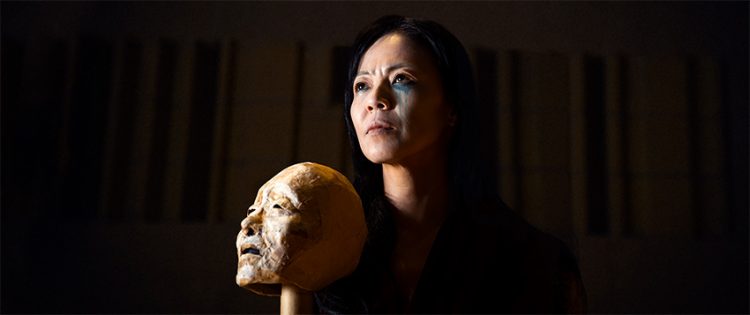Blood Moon at Prototype Festival
by Gregory Moomjy
Opera is full of ghost stories.
Throughout the centuries audiences have thrilled to Lucia going insane while being tormented by the spirits of Scottish paramours or watching the Flying Dutchman’s quest for unconventional love unto death. In more modern times, the ghosts in John Corigliano’s Versailles have made audiences both laugh and shed a tear.
This January yet another ghost story Blood Moon, written by Garrett Fisher to a text by Ellen McLaughlin had its New York premiere at the Prototype Festival. The brainchild of Beth Morrison Projects, the Prototype Festival showcases new operas that are either completed or still in a workshop state. Many of these pieces, such as David T. Little’s apocalyptic heavy metal opera Dog Days, are now established works in the 21st Century operatic canon.
Blood Moon is based on a Japanese Noh play about three characters who encounter each other once again, many years after a tragic death. A nephew, who left his aunt to die on a mountain, the ghost of his aunt, and the moon who watches over them, just like it had done on the night of the aunt’s death.
Noh is possibly Japan’s oldest form of theater, its most salient characteristics are the prevalent use of dance, masks and interactions between the mortal and spirit realms. Additionally, those who are connoisseurs of noh recognize its extremely formal structure in which the action is very slow and not much happens for large portions of the play. The creators of this opera can congratulate themselves on creating a cinematic score with imaginative orchestration. A combination of cello, drums, alto flute, bamboo flute, harmonium and keyboard create a rather eerily atmosphere. Unfortunately, that spooky sound world remains static for much of the opera and yet, strangely, by the time the opera reaches its conclusion you are left wanting more. The only explanation I can think of for this phenomenon is an uncanny ability on the composer’s part to tap into the ethos of a noh play.
The production was a true Wagnerian gesamtkunstwerk where everything; the lighting, projections, costumes and puppetry created a cohesive whole. The costumes, which were designed by Maiko Matsushima, reflected key aspects of each character’s personality. The Moon’s outlandish robe symbolized its divinity. The Nephew’s contemporary jacket showed him to be the youngest character, both chronically and emotionally. The Aunt’s kimono reflected her more traditional outlook.
The backdrop consisted of a projection of the moon which was occasionally covered by shadows, such as when the Aunt reminisced about how she felt looking up in the sky while she was dying. A ghostly puppet, operated by Takemi Kitamura, which symbolized the Aunt’s appearance, was appropriately haggard looking. The use of a red light to highlight tensions as the opera came to its climax was a crucial element of the production.
The decision to portray The Moon as a countertenor was spot-on. Ju-eh/Juecheng Chen falsetto has an otherworldly alto timbre. This follows in a long line of operatic deities sung by higher voices as a signifier that they are not of this world like Gluck’s Orpheus or Ariel in The Tempest by Thomas Adès. As the Aunt, Nina Yoshida Nelsen, used her plaintive mezzo to empathize her character’s forlorn nature. Wei Wu has a strong, clear baritone as the Nephew which he used to great effect to illustrate his need for closure. On the whole, it was a worthwhile evening in the theater. This opera should definitely be seen, it’s a great example of what can happen when two distinct musical traditions meet and combine. Even though parts of it are slow, there is definitely payoff.
Eventually, if you let the music wash over you, you’ll get sucked into the drama and you will leave wanting more.

